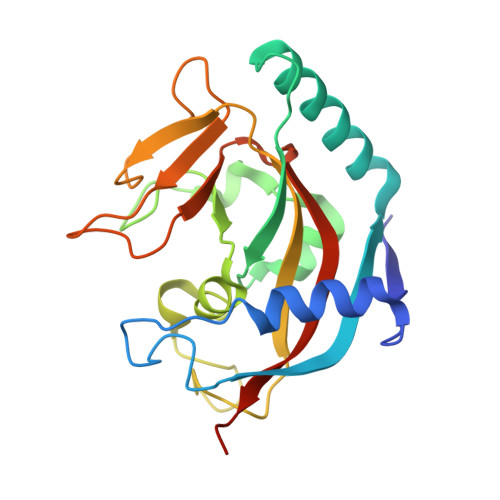Development of novel dual binders as potent, selective, and orally bioavailable tankyrase inhibitors.
Hua, Z., Bregman, H., Buchanan, J.L., Chakka, N., Guzman-Perez, A., Gunaydin, H., Huang, X., Gu, Y., Berry, V., Liu, J., Teffera, Y., Huang, L., Egge, B., Emkey, R., Mullady, E.L., Schneider, S., Andrews, P.S., Acquaviva, L., Dovey, J., Mishra, A., Newcomb, J., Saffran, D., Serafino, R., Strathdee, C.A., Turci, S.M., Stanton, M., Wilson, C., Dimauro, E.F.(2013) J Med Chem 56: 10003-10015
- PubMed: 24294969
- DOI: https://doi.org/10.1021/jm401317z
- Primary Citation of Related Structures:
4MSG, 4MSK, 4MT9 - PubMed Abstract:
Tankyrases (TNKS1 and TNKS2) are proteins in the poly ADP-ribose polymerase (PARP) family. They have been shown to directly bind to axin proteins, which negatively regulate the Wnt pathway by promoting β-catenin degradation. Inhibition of tankyrases may offer a novel approach to the treatment of APC-mutant colorectal cancer. Hit compound 8 was identified as an inhibitor of tankyrases through a combination of substructure searching of the Amgen compound collection based on a minimal binding pharmacophore hypothesis and high-throughput screening. Herein we report the structure- and property-based optimization of compound 8 leading to the identification of more potent and selective tankyrase inhibitors 22 and 49 with improved pharmacokinetic properties in rodents, which are well suited as tool compounds for further in vivo validation studies.
- Department of Chemistry Research and Discovery, ‡Department of Pharmacokinetics and Drug Metabolism, §Oncology Research, ∥Department of Molecular Structure, ⊥Bioassay and Profiling, and #Pharmaceutics, Amgen Inc. , 360 Binney Street, Cambridge, Massachusetts 02142, United States.
Organizational Affiliation:


















